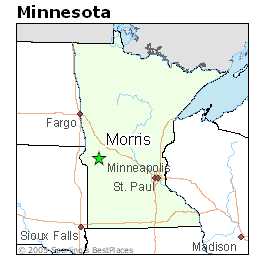 |
| Our old public school, set to be razed |
The same cannot be said for our old public school. The wrecking
ball is reportedly set to arrive there. That "ball" is part of our
conception of how these things are done. We might also envision those
demolitions where explosives are set here and there, the building comes
down and the whole thing ends up on a cable TV news channel.
I'm not sure if these popular scenarios are going to unfold here.
The whole thing may well end up more dull, as often happens in reality.
I think it's sad to juxtapose those visions of destruction with
those old UMM campus buildings that have been so well preserved.
Our old public school was developed like an erector set. I'm sure
the original 1914 structure was deemed quite grand. I'm sure it was
considered absolutely momentous when it opened in Morris in 1914. It
stood alone then. The main entrance was an inviting place that could be
seen for several blocks down Sixth Street.
The school occupied a prominent position, being on high ground.
"The hill," some people called it. I remember a Morris mayor from many
years ago who felt the school staff was becoming a little aloof and
arrogant, and he said their attitude was one of "leave us alone up here
on the hill." Well, OK.
East Seventh Street was the main entrance to Morris from the east
in an earlier time. It passed by the school on the north side.
Businesses with a fair amount of people traffic were located along that
street. Remember when the Dairy Queen was there? It's been a while now.
We all wax nostalgic thinking about the "Pylin." That was a
drive-in that would seem most apt in a movie like "American Graffiti."
I acquired my considerable amount of baseball cards mostly at
Stark's Grocery. I then had an acquaintance sell them for me in the
1980s on commission. I netted a considerable amount. I hear that today,
the market has fallen for baseball cards mainly due to saturation. I did
well selling mine when I did. I probably paid for a Las Vegas trip or
two, seriously.
I'm a little stunned that today, the old Stark's building houses a tombstone business!
Lesmeister Motors along East 7th Street is still there. Us kids
could examine Army surplus items there once. Need a good canteen?
What's sad is to reflect on how the area including the school was
so "hopping" with people activity once. Babe Ruth baseball teams had
their practice on the playground. The community was proud of that school
campus through much of its history. Toward the end we weren't supposed
to say much positive about it. The politics were that we were supposed
to push hard for something new.
We certainly got something new. Past generations could not have
imagined how spectacular our new school is. They'd say "where the heck
does the money come from?" My, they'd faint seeing the concert hall.
Heck, I practically did. Ditto the new varsity gymnasium.
I remember how momentous it was when we abandoned the old gym of
the old school and moved into the 1968 gym. How we celebrated that! The
old gym was a charming place but it was too small and not tailored to
contemporary varsity sports. Let's not forget that these old facilities
"had their time."
Sometimes I think we're too eager to dismiss old facilities as just
being worthy of the wrecking ball, as we lose our sense of history and
appreciation. The old gym is where the 1955 Morris High basketball team
played en route to making the one-class state tournament (like in the
movie "Hoosiers"). How exciting that ride must have been! Imagine the
thrills.
The term "gym" was interchangeable with "auditorium." Let's
emphasize this was an art deco auditorium, built as an addition to the
anchor 1914 structure. I'm sure the auditorium was deemed just as grand
at the time of its opening. I'm assuming there was a grand opening in
which the whole Morris community burst its buttons. Contrast that to how
the community just shrugged and said we had to move on from the old
school, as if that facility had lost all useful purpose.
Maybe it's true we had no choice but to move on. Maybe we had no
choice but to leave the old public school campus crumbling and pathetic,
as it has been for the last several years. Could we not have demolished
it sooner? I'm puzzled about this. The inside has become sickening with
its decay.
Meanwhile we see old buildings on the University of
Minnesota-Morris campus retain their usefulness. Take a look at the
Welcome Center. Or better yet, admire the Multi-Ethnic Resource Center
which seems ancient with its background. That building housed music when
UMM first began. I have reason to remember that well. I remember
getting in trouble when I played a record of John Philip Sousa music a
little too loud!
Our UMM campus of today has a varied history, all beginning with
the "Indian school." We're going all the way back to the late 1880s. The
1880s were a time of prosperity and rapid development in Morris. We saw
several Victorian style homes (or mansions) go up around town. There
was sort of a fortress mentality behind building such elaborate homes, I
have read, based on the dangers of the outside world.
The music building where I played that Sousa record dates back to 1899. The Sisters of Mercy established the Indian school. It never
really got firm footing. It closed for four years, then was
re-established by the Federal Government with little commitment or
resources.
The 20th Century arrived. Those behind the Indian school may have
meant well, but the objective of trying to "westernize" the Native
Americans seemed dubious. Let's say it reflected cultural bias.
In 1910 a major new chapter began for the campus. It was time for
the storied West Central School of Agriculture to open its doors. The
campus was a collection of 13 buildings at that time. Included were a
hospital and morgue!
That old anchor building which today is the Multi-Ethnic spot was designated for agronomy.
We saw two new dormitories built in 1911.
The agriculture faculty was augmented by home economics. The
faculty taught and researched. Crop rotation was a research priority.
The WCSA would later carve out a distinct reputation for sheep and lamb
research.
The WCSA had a period of fits and starts at the beginning. It
really landed on its feet in the 1920s, so that by 1929, enrollment was
up at a robust 388. The fits and starts weren't over though. The Great
Depression and some poor harvests held back the WCSA.
Today the State of Minnesota seems to guarantee continuity. Such
wasn't the case way back when, when the school had to adjust to vagaries
of the world around us. The Depression was far-reaching. Families
became hard-pressed sending their children to school.
The state finally decided some continuity was needed, so in 1935
the legislature passed a bill providing for state payment of tuition.
Today "financial aid" has ironically pushed the cost of post-high school
education way up, to where many experts feel we have a "higher
education bubble." In '35 the state's gesture seemed more logical and
practical. It may have literally kept our campus going. Enrollment grew
back up to 391.
One crisis gave way to another. After the Depression we became
focused on war. War was weighed as early as 1940. The WCSA responded by
developing an aviation training program. We were a "primary aviation
training school." The new Morris airport was weaved into this endeavor.
The America Firsters fought hard to keep the U.S. isolated from the
European conflagration. We might forget how popular the Firsters
organization was. Charles Lindbergh was a top spokesman. Alas the
Firsters seemed to disappear overnight with the Japanese bombing of
Pearl Harbor.
The U.S. got dragged through World War II, did its job,
extinguished Fascism, and then it was time to return to some normalcy.
The WCSA took on a very thriving tone. Enrollment burgeoned up to 455 -
wow! - for the fall of 1947. That figure would be an all-time high.
The campus had setbacks in the form of fires in 1949 and 1950. The
school began requiring a fourth year of studies. By 1952 this was
totally established. Previously the fourth year was optional.
We saw some new construction in the 1950s. But oh my, outside
circumstances were about to intervene again. The nature of farming was
changing. The WCSA was established on the assumption that many farm kids
had to be available for farm labor at home much of the year. Their
studies had to be compressed into a shorter school year. Technological
inroads were wiping out this limitation for "farm kids."
We would see an end to the "ag schools."
UMM began as sort of an awkward little duckling breaking out of its
shell in 1960. The WCSA and UMM would co-exist for a short time. Then,
no more WCSA. The WCSA's experiment station would survive. Today it's
known as the WCROC ("the rock").
The last WCSA grads got their diplomas in 1963. Now it was time for
UMM to bloom. The first UMM graduation was held in 1964. I was there.
UMM campus architecture reflects its history. The old has been
preserved. Such is not the case with our old public school which
apparently is soon to come down. The "look" of that part of town will
certainly change. Will things be better there? Will we see development?
I'm not too optimistic about that.
If the best we can hope for is expansion of the cemetery, well. . .
- Brian Williams - morris mn minnesota - bwilly73@yahoo.com






















No comments:
Post a Comment